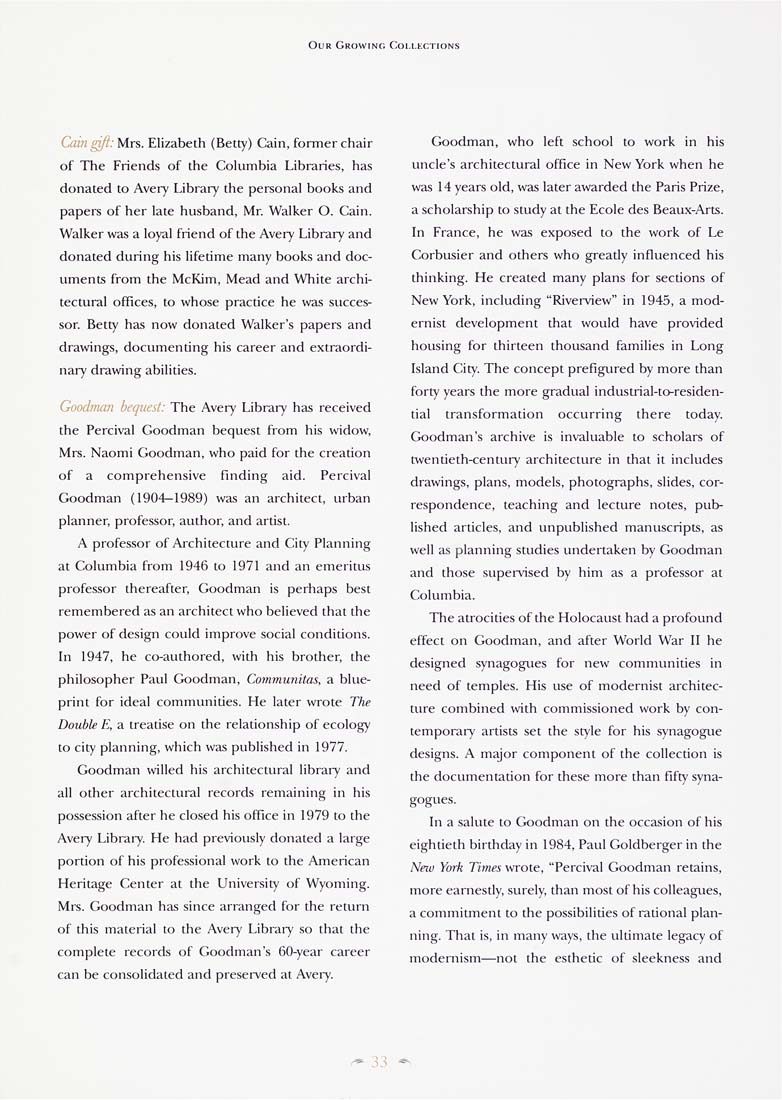Columbia Library columns (v.44(1995))
(New York : Friends of the Columbia Libraries. )
|
||
|
|
|
|
| v.44,no.1(1995:Winter): Page 33 |

C(zm^; Mrs. Elizabeth (Betty) Cain, former chair of The Friends of the Columbia Libraries, has donated to Avery Library the personal books and papers of her late husband, Mr. Walker O. Cain. Walker was a loyal friend of the Avery Library and donated during his lifetime many books and doc¬ uments from the McKim, Mead and White archi¬ tectural offices, to whose practice he was succes¬ sor. Betty has now donated Walker's papers and drawings, documenting his career and extraordi¬ nary drawing abilities. Goodman bequest: The Avery Libraiy has received the Percival Goodman bequest from his widow, Mrs. Naomi Goodman, who paid for the creation of a comprehensive finding aid. Percival Goodman (1904—1989) was an architect, urban planner, professor, author, and artist. A professor of Architecture and City Planning at Columbia from 1946 to 1971 and an emeritus professor thereafter, Goodman is perhaps best remembered as an architect who believed that the power of design could improve social conditions. In 1947, he co-authored, with his brother, the philosopher Paul Goodman, Communitas, a bltie- prinl for ideal communities. He later wrote The Double E, a treatise on the relationship of ecology to city planning, which was published in 1977. Goodman willed his architectural library and all other architectural records remaining in his possession after he closed his office in 1979 to the Avery Library. He had previously donated a large portion of his professional work to the American Heritage Center at the University of Wyoming. Mrs. Goodman has since arranged for the return of this material to the Avery Library so that the complete records of Goodman's 60-year career can be consolidated and preserved at Avery. Goodman, who left school to work in his imcle's architectural office in New York when he was 14 years old, was later awarded the Paris Prize, a scholarship to study at the Ecole des Beaux-Arts. In France, he was exposed to the work of Le Corbusier and others who greatiy influenced his thinking. He created many plans for sections of New York, including "Riverview" in 1945, a mod¬ ernist development that wotild have provided housing for thirteen thousand families in Long Island City. The concept prefigured by more than forty years the more gradual industrial-to-residen¬ tial transformation occurring there today. Goodman's archive is invaluable to scholars of twentieth-century architecture in that it includes drawings, plans, models, photographs, slides, cor¬ respondence, teaching and lecture notes, pub¬ lished articles, and unpublished manuscripts, as well as planning studies undertaken by Goodman and those supemsed by him as a professor at Columbia. The atrocities of the Holocaust had a profound effect on Goodman, and after World War II he designed synagogues for new communities in need of temples. His use of modernist architec¬ ture combined with commissioned work by con¬ temporary artists set the style for his synagogue designs. A major component of the collection is the documentation for these more than fifty syna¬ gogues. In a salute to Goodman on the occasion of his eightieth birthday in 1984, Paul Goldberger in the Neu) York Times wrote, "Percival Goodman retains, more earnestly, surely, than most of his colleagues, a commitment to the possibilities of rational plan¬ ning. That is, in many ways, the ultimate legacy of modernism—not the esthetic of sleekness and 33 |
| v.44,no.1(1995:Winter): Page 33 |







